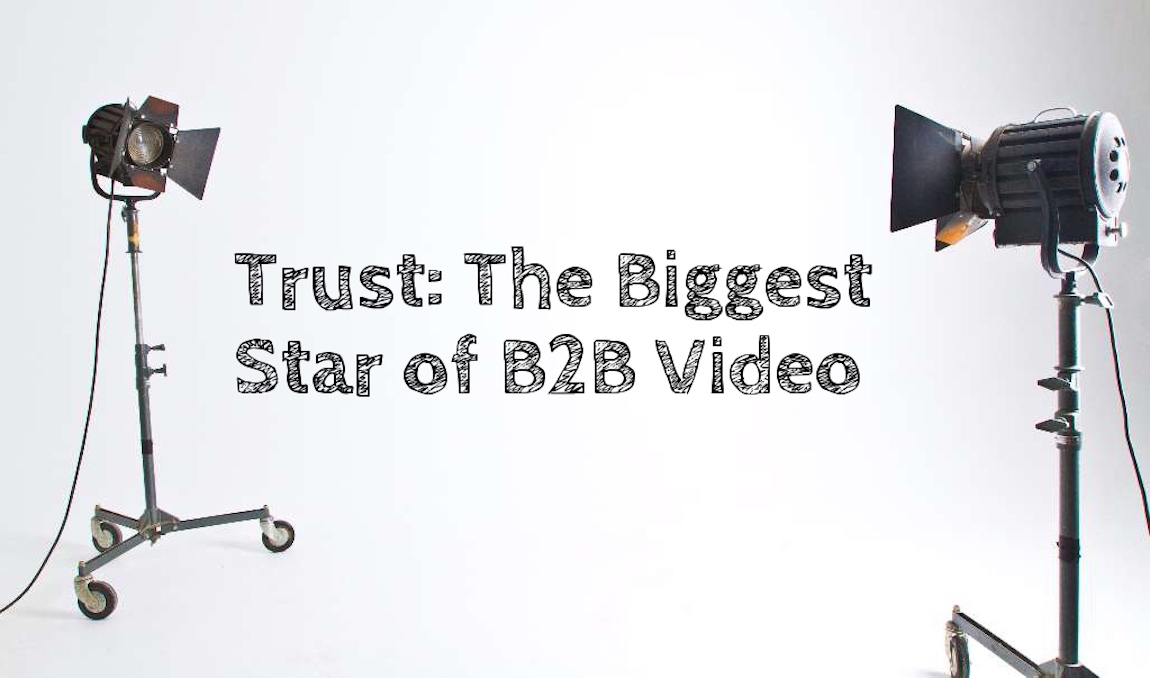B2B Myth of the Week: Any Video Is a Good Video
by MGB2B
The Myth: Any Video Is Good Video
The Truth: Good Video Starts with Good Strategy
Video! Video! Video!
“Everyone wants video. We better get one made pronto!”
Sound familiar? It’s a sentiment echoing in conference rooms and boardrooms all across the country. Everyone knows that video is important because it’s what most customers like to consume.
But before you dive into the world of video, it’s important to determine a few things. You need to build a video strategy. Because not all videos are effective for every brand and every industry. Every company’s needs and goals are different. So the best way to get started is by asking yourselves – and possibly your customers – some key questions.
Here Are 6 Questions to Drive Strategy and Inspire B2B Video Ideas for Your Brand:
- What Kind of Video Do My Customers Want/Need? This is the most important question you can ask. Sure, everyone loves a good cat video. But what kind of video do your customers crave that is relevant to your brand or products. Presumably, you have a database. Send your people an incentivized survey. They’d be happy to tell you if they want to see product training videos, Q&A with an industry expert, or a simple whiteboard video with tips on certain types of projects. After all, these are the people you want to look at your videos. Why deliver them something generic when you can actually give them helpful insights that establish your brand as a thought leader?
- What Is the Purpose of the Videos We Are Creating? Developing video content without knowing why you’re doing it is a waste of money. Hence, it’s important to have clear goals in mind. Are you simply trying to build awareness of your brand? A factory tour or brand video might work best. Or do you want prospects to take some sort of action based on what they see? In this instance, you might want to use a video case study. By figuring out what you want to get out of the videos you create, you can be more effective. Plus, you’ll be able to measure your success to determine which types of videos you should create down the road.
- Are There Videos That Can Be Helpful Internally as Well as to a Broader Audience? Sometimes your internal salespeople or reps can use video to sell or train clients. Ask them what they would find helpful for closing a sale. Sometimes the answers to Questions 1 & 3 can result in a video that serves both purposes.
- What Resources Do We Have Access To? Do you have someone internally that can produce and edit videos? Do you work with an agency or a freelancer who can do it? Perhaps you have a ton of footage on file and just need help making it flow better. You can also tap production people for ideas. Sometimes those who touch video every day can see things from a different perspective you haven’t considered. Therefore, it’s a good idea to make a list of everyone who can help. Then figure out where the gaps are, and start researching who can fill them.
- What Is Our Budget for Video? Obviously, the type of video you create depends on your budget. If you have a pie-in-the-sky budget, there are no limits to what kind of video you can produce. But if you have a tight budget, you’ll need to tailor your ideas to what you are capable of producing without sacrificing quality. A day of professional filming on-site, for instance, can cost a lot more than a video that uses vector art. So you’ll have to examine the demand from your audience against your budget and come up with ideas that satisfy both.
- How Will We Distribute the Videos We Create? Are you creating a video just to put on your Facebook page? Then you might want to do something geared specifically toward an audience that is already in your sales funnel but may not have converted. A case study or how-to video might be more effective in this case. Are you planning on putting it on your website for everyone to see? That’s where your general brand video or product demos might work best.
There are lots of things to take into consideration. You can scan the Internet for B2B video ideas all day long and come up with an extensive list. But in order to create good videos that guide prospects into and through your sales funnel, you need to sit down, look at the big picture, and answer the questions above. It’s the difference between video content that sits on YouTube collecting dust and video content that converts into sales.
Continue ReadingB2B Myth of the Week: Video Content Is Too Expensive
by MGB2B
“We can’t afford to do video.”
“A video guy is going to be too expensive.”
“Who’s going to write it? Who’s going to edit it?”
Lots of questions start to swirl around when you talk about B2B video content. But video is actually not as complicated as it used to be. And if you partner with the right vendors or agency, you can get a high-quality piece of content that suits your budget.
So What’s the Best Way to Get Started on Video Content for B2B Brands?
If you have no idea where to begin or don’t have the resources to commit to exploring your options, a B2B marketing agency can help evaluate and negotiate with illustrators, video producers, editors, and online video resources that do it all. Whether or not you use an agency, here’s what you’ll need to do first.
- Know Your Purpose. What is the goal of your video? Lots of B2B brands know that they “must have a video” and create one just to put an X in a box. But you need to take a step back and think about why you need a video. Perhaps you need an educational video series to build credibility in your industry. Or a simple explainer video to educate about the use or installation of a specific product. Maybe you want a polished brand video to put on your homepage. Knowing your purpose and the story you want to tell will help you with the very important next step…
- Set a Definitive Budget. The simple way to avoid being overwhelmed by the cost of video is to include it in your marketing budget from the beginning. It seems like common sense. But a lot of companies skip this part. Can you only spend $2,000? Or can you spare $10,000? Different price points get you very different types of videos and levels of quality. Knowing your budget will allow you or your agency to select the right video partners.
- Evaluate Quality vs. Cost. When determining who to partner with, obviously cost is a consideration. If your budget is only a few thousand dollars, you’ll likely need to go with an online vendor instead of having a professional shoot. But quality can be questionable. Make sure you look at value instead of going with the cheapest option. Ask yourself: “What level of quality, speed, and service am I getting for the price?” It takes a lot of research to find the right fit. So if you choose not to hire a marketing agency, make sure you have someone in-house who can devote a significant amount of time to weighing quality vs. cost.
- Don’t Skip the Script. Know exactly what you want to say and show in your video. Don’t “wing it.” A script and/or storyboard will help guide you along right from the drawing board. While it’s not something that directly affects your budget, it will keep everyone involved on track to produce more quickly and efficiently. This will help you spend less time (and money) in the editing room.
Creating video content for B2B brands is almost a necessity in 2018. And there are certainly many affordable options out there. The most important thing is to do it right, building trust in your brand and ultimately boosting ROI. Follow the steps above, and you’ll be a few steps ahead of your competitors.
Continue ReadingUsing B2B Video Content To Boost Understanding and Trust in Your Products
by Ben Quinn
How the Brain Processes Video Content
Sell sheets are nice. But when you want to tout your product benefits and truly engage your customers, look to B2B video content. Why? Our brains are wired to understand stories better than bulleted facts. According to a study done by MIT, the brain can process images viewed for as little as 13 milliseconds. By contrast, text is processed at a much slower rate. Using B2B video content allows you to get your message across much faster. Consider why the most successful presentations we experience in business are full of visual information.
An Example of an Effective B2B Product Demo Video
This video from Milwaukee is a good example of a product demonstration video. It takes all the selling points of their M18™ ForceLogic™ Commercial Crimper and Cable Cutter and brings them to life. Hearing and seeing product specs from the mouths of people who use the products is much more effective and memorable than distributing text that promises results, but gives no visual confirmation of the results.
Using Video for Search and Social
So our brains are wired to understand video better than text alone, but a video is only as effective as the number of eyes that see it. When optimized correctly, video can help increase your search rankings. An investment in video also pays off by giving you interesting content for all of your social media outlets. You are more likely to gain traction and engagement by posting a relevant video than a simple link to, say, your new 30-page product catalog.
Video Content Is Like Pizza – Even When It’s Bad, It’s Still Pretty Good.
Your videos do not need to be the next great feature films. Getting meaningful content to the viewer is much more important than the quality of the recording. Research shows that people are more put off by videos that don’t explain a product or service clearly than by poor quality design. That’s not to say you shouldn’t make a piece worth watching. But relatable content trumps Hollywood polish.
Check out this video series created by etrailer.com. They don’t use expensive on-screen talent or high tech animations, just clear useable information that is super helpful if you are looking to install a trailer hitch on a 2015 Nissan Frontier. They set up a simple logo backdrop and created hundreds of videos with different truck models, so that when a potential customer searches for “how to install a trailer hitch on my [your vehicle here],” they are the first option that comes up. This video series allows them to both build awareness of their product offerings, and give customers confidence in how easy it is to use their products. This method of marketing also strengthens the sense of trust with the company. The eyes don’t lie; people love to see products in action instead of simply taking the company’s word for it.
In conclusion, there are many benefits to making video content a key part of your marketing strategy. It promotes greater understanding of your product offering while also building trust in your products and brand in general. With video recording devices and internet platforms being more accessible than ever before, a small marketing budget can still produce large returns with this dynamic medium. Put some money behind these videos, and you have a platform that can both elevate your brand and leave your potential customers with a memorable experience.
Continue Reading

